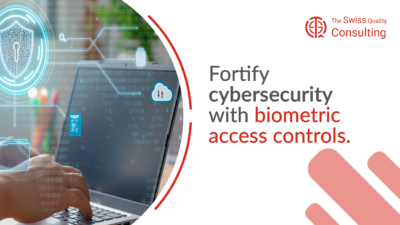Fortifying Cybersecurity with Biometric Access Controls: Enhancing Security and Efficiency in the Digital Age
Introduction
In an era where digital security is paramount, fortifying cybersecurity with biometric access controls has become crucial for businesses of all sizes. This article aims to provide business executives, mid-level managers, and entrepreneurs with insights into how biometric technology can enhance their cybersecurity measures and contribute to overall business success.
The Rising Need for Advanced Cybersecurity Measures
In the face of an increasingly complex and evolving cyber threat landscape, traditional security protocols, often relying solely on passwords and static user authentication methods, are proving to be inadequate in safeguarding sensitive data and preventing unauthorized access. Amidst this growing cybersecurity imperative, biometric access controls have emerged as a transformative and comprehensive solution, offering enhanced security, efficiency, and user convenience.
Biometric access control systems, powered by cutting-edge technologies such as fingerprint recognition, facial recognition, and iris scanning, leverage unique physical characteristics of individuals to grant access to secure premises, devices, and data. Unlike traditional password-based authentication, which is vulnerable to theft, phishing attacks, and password fatigue, biometric access controls provide an inherent layer of security that is difficult to replicate or forge. This inherent security stems from the uniqueness and permanence of individual biometric traits, making them virtually impossible to duplicate or bypass.
Beyond enhanced security, biometric access controls offer a range of additional benefits that contribute to overall organizational effectiveness. These benefits include:
Convenience and Efficiency: Biometric authentication eliminates the need for remembering and managing complex passwords, streamlining the access process and reducing friction for authorized users.
Reduced Risk of Human Error: By eliminating password-based authentication, biometric access controls minimize the risk of human error, such as forgotten passwords or mistyped credentials, which can lead to unauthorized access attempts.
Enhanced User Experience: Biometric authentication provides a seamless and user-friendly access experience, eliminating the frustration and inconvenience associated with password management.
Scalability and Adaptability: Biometric access control systems can be seamlessly integrated into existing security infrastructure and scaled to accommodate a growing workforce or changing access requirements.
Improved Data Protection: By safeguarding access to sensitive data with biometric authentication, organizations can minimize the risk of data breaches and protect the privacy of their employees and customers.
In essence, biometric access controls have revolutionized the landscape of cybersecurity, providing organizations with a robust and multifaceted approach to protecting their assets and safeguarding their data. By embracing biometric authentication, organizations can enhance security, streamline access, improve user experience, and safeguard their sensitive information in the face of increasingly sophisticated cyber threats.
Integration of Biometrics in Business Security Systems
Integrating biometric technology into business security systems isn’t just about adding a layer of security; it’s about transforming the way businesses protect their data and assets. This integration requires a well-planned change management strategy, ensuring smooth adoption and minimal disruption to operations.
Executive Coaching for Effective Biometric Implementation
Effective implementation of biometrics is not solely a technical challenge but also a leadership one. Executive coaching services can play a vital role in preparing leaders for this transition. Coaching helps in developing necessary skills for managing change, communicating effectively with stakeholders, and making informed decisions about cybersecurity investments.
Effective Communication in the Era of Cybersecurity
Communicating the importance of cybersecurity and the role of biometrics is critical for gaining buy-in from all levels of the organization. Leaders must articulate the benefits and the need for change clearly and convincingly to ensure organization-wide support for these initiatives.
Leveraging Generative AI for Enhanced Security Protocols
Generative Artificial Intelligence can be a game-changer in cybersecurity. AI can analyze patterns and predict potential breaches, allowing for proactive security measures. In the context of biometrics, AI can enhance the accuracy and efficiency of recognition systems, thus bolstering the overall security infrastructure.
Biometrics: A Tool for Effective Leadership and Management
Adopting biometric access controls also reflects on a company’s leadership and management style. It demonstrates a commitment to innovation and a proactive approach to risk management. Furthermore, it instills a sense of security and trust among employees, clients, and stakeholders.
Conclusion
The implementation of biometric access controls is not just a technological upgrade but a strategic business decision. By embracing this advanced security measure, businesses not only protect themselves against cyber threats but also position themselves as forward-thinking and responsible entities in the digital age.
#Cybersecurity #BiometricSecurity #DigitalTransformation #BusinessProtection #LeadershipInTech #RiskManagement






















